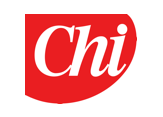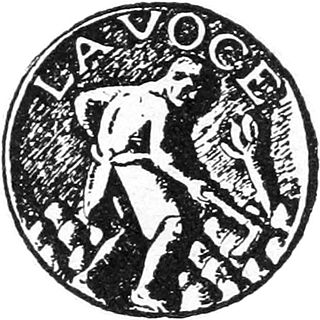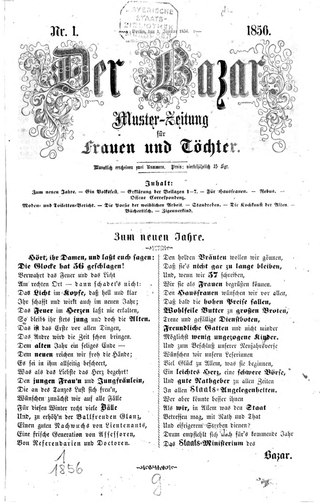Related Research Articles
Famiglia Cristiana is an Italian weekly magazine published in Alba, Italy. The magazine is a Catholic news magazine and has been in circulation since 1931.
Arnoldo Mondadori Editore is the biggest publishing company in Italy.

Chi is an Italian weekly gossip magazine geared towards a female viewership published in Milan, Italy.

Angelo Rizzoli, OML was an Italian publisher and film producer.
RCS MediaGroup S.p.A., based in Milan and listed on the Italian Stock Exchange, is an international multimedia publishing group that operates in daily newspapers, magazines and books, radio broadcasting, new media and digital and satellite TV. It is also one of the leading operators in the advertisement sales & distribution markets.
Gente is a popular and long-running Italian weekly current affairs and celebrity gossip magazine.

Oggi is an Italian weekly news magazine published in Milan, Italy. Founded in 1939 it is one of the oldest magazines in the country.

La Voce was an Italian weekly literary magazine which was published in Florence, Italy, between 1908 and 1916. The magazine is also one of the publications which contributed to the cultural basis of the early forms of Fascism.

Epoca was an Italian illustrated weekly current events magazine published between 1950 and 1997 in Milan, Italy.

Il Mondo was a weekly political, cultural and economic magazine founded by Gianni Mazzocchi and directed by Mario Pannunzio. It existed between 1949 and 2014.
Amica is an Italian language monthly fashion and women's magazine based in Milan, Italy. It has been in circulation since 1962. The magazine has several international editions published in Bulgaria, Indonesia and Singapore.
IO Donna is a weekly women's magazine and Saturday supplement of the Italian daily newspaper Corriere della Sera. The magazine is the first supplement of a daily which focuses on women readers. It is based in Milan, Italy.
Candido was an Italian language satirical magazine published in Milan, Italy, between 1945 and 1961.
Ottavia Vitagliano was an Italian writer, editor and publisher.
Omnibus was a weekly illustrated general cultural magazine published in Milan, Italy, between 1937 and 1939. Its subtitle was settimanale di attualità politica e letteraria. It is described as the "father of Italian magazines", especially in regard to the use of photographs and images. The magazine was closed by the fascist authorities.
Lo Sport Fascista was a monthly sports magazine which was published in Milan, Italy, during the fascist rule as the official organ of the fascist government. The magazine was in circulation between 1928 and 1943.

Der Bazar was a fashion magazine which was published in Berlin, Germany, in the period 1854–1933. Its subtitle was first Technische Muster-Zeitung für Frauen. Then it was changed to Illustrirte Damen-Zeitung from 1 January 1857. It is one of the earliest examples of a multilingual magazine.
Annabella was an Italian women's magazine which existed between 1933 and 1983 with a one-year interruption from 1944 to 1945.
Eva was a weekly women's magazine which was published between 1933 and 1968 in Milan, Italy, with a two-year interruption. Its subtitle was settimanale per la donna italiana. Eva was one of the leading illustrated magazines of the period.
References
- ↑ Jennifer A. Myers (2011). Everybody's Woman: Gender, Genre, and Transnational Intermediality in Inter-War Italy (PhD thesis). University of Washington. p. 62. ISBN 978-1-124-84509-8. ProQuest 888160875.
- ↑ "1940s/1950s/Early 1960s Italian Women's Magazines". Listal. 28 January 2014. Retrieved 26 April 2015.
- 1 2 3 Andrew Whittaker, ed. (2010). Italy: Be Fluent in Italian Life and Culture. Thorogood Publishing. p. 225. ISBN 978-1-85418-628-7.
- ↑ Gabriella Bosano (November 1926). "Current Italian Periodicals". Italica. 3 (4): 83. JSTOR 476108.
- ↑ David Forgacs; Stephen Gundle (2007). Mass Culture and Italian Society from Fascism to the Cold War. Bloomington, IN: Indiana University Press. p. 99. ISBN 978-0-253-21948-0.
- ↑ Deirdre Pirro (29 September 2011). "Angelo Rizzoli. From magazines to movies". The Florentine (149).
- ↑ Fabrizio Tonello (2007). "The Italian Media Landscape". In Georgios Terzis (ed.). European Media Governance: National and Regional Dimensions. Bristol; Chicago, IL: Intellect Books. p. 242. ISBN 978-1-84150-192-5.
- ↑ Diego Ceccobelli; Antonio Ciaglia; Marco Mazzoni (14 December 2012). "Berlusconi's Pop-Politics: When the Private and Public Spheres Converge" (Conference paper). University of Salford. Retrieved 26 April 2015.
- ↑ Marco Mazzoni; Antonio Ciaglia (2013). "How Italian politics goes popular: Evidence from an empirical analysis of gossip magazines and TV shows". International Journal of Cultural Studies. 17 (4): 381–398. doi:10.1177/1367877913496199. S2CID 153639453.
- 1 2 Irene Piazzoni (Summer 2020). "Shaping a Weekly 'For Everyone': Italian Rotocalchi Entre-Deux-Guerres". Journal of European Periodical Studies. 5 (1): 31. doi:10.21825/jeps.v5i1.16525. S2CID 225721009.
- 1 2 3 Fabio Guidali (Winter 2019). "Developing Middlebrow Culture in Fascist Italy: The Case of Rizzoli's Illustrated Magazines". Journal of European Periodical Studies. 4 (2): 106–121. doi:10.21825/jeps.v4i2.10774. hdl: 2434/740036 . S2CID 213408933.
- ↑ Maria Antonella Pelizzari (2015). "Make-believe: fashion and Cinelandia in Rizzoli's Lei (1933–38)". Journal of Modern Italian Studies. 20 (1): 41. doi:10.1080/1354571X.2014.973153. S2CID 144013857.
- ↑ Antonio Ciaglia; Marco Mazzoni (2014). "Pop-politics in times of crisis: The Italian tabloid press during Mario Monti's government". European Journal of Communication. 29 (4): 449–464. doi:10.1177/0267323114529535. S2CID 144183208.
- ↑ Ilaria Parini (2008). "Domesticating or foreignizing texts? Niccolò Ammaniti's Ti Prendo e Ti Porto Via translated into English". In Rebecca Hyde Parker; Karla Guadarrama Garcia (eds.). Thinking Translation: Perspectives from Within and Without: Conference Proceedings, Third UEA Postgraduate Translation Symposium. Boca Raton: Brown Walker Press. p. 138. ISBN 978-1-59942-461-3.
- ↑ "RCS MediaGroup SpA". Bloomberg Business. Retrieved 26 April 2015.
- ↑ Mark Gilbert; Robert K. Nilsson, eds. (2007). Historical Dictionary of Modern Italy. Lanham, MD: Scarecrow Press. p. 355. ISBN 978-0-8108-6428-3.
- ↑ Franca Merlonghi; Ferdinando Merlonghi; Joseph Tursi; Brian O’Connor (2011). Oggi In Italia: A First Course in Italian. Australia: Cengage Learning. p. 400. ISBN 978-1-133-17121-8.
- ↑ Mitchell V. Charnley (September 1953). "The Rise of the Weekly Magazine in Italy". Journalism Quarterly. 30 (4): 477. doi:10.1177/107769905303000405. S2CID 191530801.
- ↑ Maria Teresa Crisci. "Relationships between numbers of readers per copy and the characteristics of magazines" (PDF). The Print and Digital Research Forum. Retrieved 26 April 2015.
- ↑ "Rcs Mediagroup" (PDF). Borsa Italiana. 12 March 2004. Retrieved 26 April 2015.
- ↑ "Dati ADS (tirature e vendite)". Fotografi (in Italian). Archived from the original on 24 April 2015. Retrieved 26 April 2015.
- ↑ Anne Austin; et al. (2008). "Western Europe Market and Media Fact" (PDF). Zenith Optimedia. Archived from the original (PDF) on 5 February 2015. Retrieved 26 April 2015.